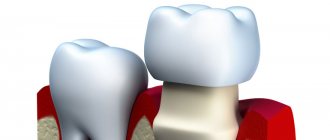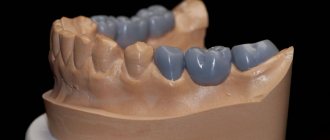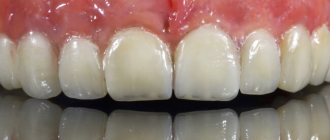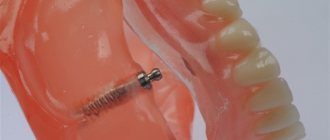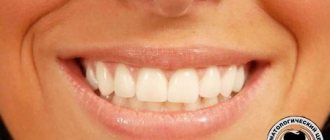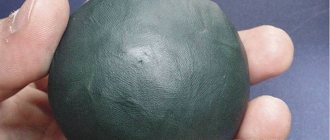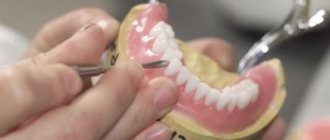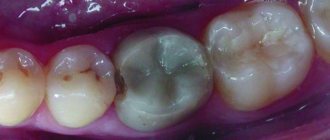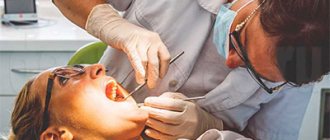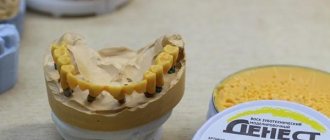Dental waxes for modeling modern denture designs
Waxes are one of the oldest materials used in dentistry. For example, beeswax began to be used for taking impressions more than 200 years ago. Nowadays waxes are used in dentistry in many cases. They are used as a temporary material from which models of inlays, crowns, pins, partial and complete dentures are created. At the stages of making wax models of future dentures, special wax compositions of auxiliary value are used; in the literature they are called auxiliary or technological waxes.
Dental waxes are classified according to their purpose, distinguishing between modeling, technological auxiliary and impression waxes. Based on the main purpose, modeling waxes include not only waxes for modeling inlays, crowns, fixed bridges, etc., but also base waxes. However, the latter are classified as a separate class of auxiliary materials, because The technology for replacing temporary wax material with a permanent acrylic base differs significantly from the technology in the manufacture of fixed denture structures, especially modern technologies for casting metal alloys using lost wax models.
Thus, modeling waxes usually include wax for inlays (inlays/onlays - inlay/onlay), veneers, veneers, casting and clasp wax (wax for modeling clasp or arched prostheses) and modeling waxes intended for modeling various types of fixed bridges , including solid metal, metal-ceramic and metal-plastic, as well as some others. Inlay wax is used to make a temporary or wax-up model of an inlay, crown, or post tooth, which is then used to create a mold used in lost-wax denture casting technology. Type I inlay wax is hard and is used to make inlays using the direct method. Type II wax is soft and is used to make wax inlays using the indirect or indirect method on models. In addition, inlay waxes are sometimes used to model attachments in combined dentures. Casting waxes are used to model the thin parts of partial dentures and the junction of crowns and pontics in bridges. They are especially suitable for the production of caps and clasps, in which it is necessary to recreate uniform thin elements.
It is clear that the quality and, above all, the accuracy of future dentures depends on the quality of the wax model. Therefore, the properties of wax modeling materials are so important, which should ensure the accuracy of the model, prevent dimensional changes and shape distortions during the process of making the model, carrying out fittings and making a mold based on the wax model. The main properties of modeling waxes that ensure the necessary accuracy of models include:
- low shrinkage when cooling the wax (<0.1 - 0.15% volume/1°C in the range from 90 to 0°C);
- good plasticity in the temperature range 41-55°C;
- sufficient hardness at a temperature of 37-40°C, ensuring preservation of the model’s shape in the oral cavity;
- absence of stickiness and delamination during processing;
- absence of noticeable ash content, in other words, elimination of the formation of plaque or soot on the walls of the mold after burning out the wax model;
- homogeneity during softening, no delamination;
- exclusion of painting the plaster model;
- the wax layer must adhere to the model and adhere to the previously applied layer of material;
- Modeling waxes should be painted in bright, contrasting colors to facilitate the modeling process.
The main of the listed requirements are included in the “Technical Requirements” section of the draft national standard GOST R for dental modeling wax, corresponding to international standard No. 1561 “Dental casting Wax”. The properties of waxes, ensuring their ability to model, good plasticity and sufficient hardness in certain temperature ranges, are established in the standards in the form of norms for fluidity indicators (see Table 1), and the ash content of these waxes, according to the requirements of the standards, should not exceed 0.1% .
Depending on the specific purpose, the composition of dental wax, or rather the wax composition, changes. But regardless of this, the basis of modeling materials are waxes - organic polymers consisting of hydrocarbons and their derivatives (for example, ethers and alcohols). The average molecular weight of waxes ranges from 400 to 4000, which is significantly lower than the molecular weight of acrylic polymers. Dental waxes are mixtures of natural (for example, paraffin, beeswax, carnauba, spermaceti, ceresin) and synthetic waxes, as well as natural polymers (for example, dammar resin), with the addition of oils and fats (for example, stearic acid), gum (gum arabic) ) and dyes.
Natural waxes can be of mineral (petroleum products), plant or animal origin. Paraffin is a relatively soft wax with a low melting point (50° to 70°C). This mineral wax is obtained from refined crude oil and is used in inlay wax compositions and for modeling dental bridges. During processing, paraffin delaminates and does not give a smooth shiny surface; the addition of dammar resin to paraffin eliminates its delamination and cracking, increases density, elasticity and gives the composition a smooth shiny surface.
Beeswax is fragile and melts in the temperature range from 60° to 70°C. This wax is obtained from the waste products of bees - honeycombs; it is added to the compositions of many waxes, to which it gives the necessary fluidity at oral temperature.
To reduce fluidity and make the surface shiny, carnauba wax is introduced in an optimal amount, but its excess can lead to coagulation - the loss of flakes when the mixture melts. Carnauba wax is a wax of plant origin, which is extracted from carnauba palm trees; it has high hardness and rigidity. Carnauba wax melts at higher temperatures (from 65° to 90°C). It is added to paraffin to increase its hardness and melting point. In modern dental waxes, carnauba wax is partially replaced by synthetic waxes.
Synthetic waxes have a certain melting point and are mixed with natural waxes. An example of a synthetic wax is low molecular weight polyethylene. The properties of natural waxes largely depend on the source of their production; this is taken into account by developers and manufacturers of dental wax compositions. In contrast, synthetic waxes are more uniform in composition.
Microcrystalline waxes melt at higher temperatures (65° to 90°C) and are added to control the temperature ranges in which wax compositions soften and melt. With their help, they reduce the stress that occurs in the wax during cooling. Microcrystalline waxes are obtained from petroleum.
Coloring waxes with various fat dyes (red, blue, green, yellow, pink) facilitates modeling on a white background of the model and often determines the purpose of the wax.
The properties of dental waxes depend not only on the composition, but also on the manufacturing technology. With imperfect technology or its violation, waxes with tension and great relaxation are obtained. The creation of waxes with stable properties (in terms of plasticity, melting point, fluidity, etc.) is significantly difficult due to the fact that the components - natural waxes do not have a strictly constant qualitative and quantitative composition. This leads to the fact that the fusion of waxes in certain proportions often does not ensure reproducibility of the properties of the composition. The use of synthetic waxes with stable characteristics as components allows us to solve this problem to some extent.
An interesting and relatively recent innovation is the creation of modeling materials that do not contain waxes. They are often called modeling plastics. Modeling materials made from light-curing polymers (for example, Triad VLC, Palavit GLC) can be used to make models of cast metal prostheses, ceramic structures and high-precision attachments. These materials are produced in the form of pastes or liquids of high and low viscosity; the basis of their composition is a diurethane methacrylate oligomer, into which from 40% to 55% of a polymer filler is introduced.
Polymer modeling materials are characterized by higher strength and stability due to low fluidity compared to traditional waxes, good dimensional accuracy and the ability to burn out without residue. A comparison of the marginal fit of crowns made using models from modeling plastic and inlay wax showed their identical quality.
The model is made from a polymer modeling material by successively applying layers of 3-5 mm, which are cured in a light chamber or using a manual light-curing apparatus. The polymer is completely burned out of the mold before casting by holding the mold at a temperature of 690°C for 45 minutes.
The composition of waxes can include both crystalline and amorphous components, each of which is characterized by its own mass-molecular distribution. Therefore, waxes melt over a very wide temperature range, and not at one specific temperature.
Waxes have the highest coefficient of thermal expansion of any other material. A high coefficient of thermal expansion is one of the disadvantages of these modeling materials, due to the very polymeric nature of the wax. As a result, significant dimensional changes in castings and poor fixation of cast prostheses could occur if the technology for compensating for dimensional changes by expanding the molding materials, as well as other methods, such as the use of compensation varnishes, was not used. The total shrinkage of wax when it is cooled from the melting point, when the wax is in a liquid state, to room temperature, at which the wax becomes solid, can reach such a significant value as 0.4%, which includes shrinkage during solidification and shrinkage caused by cooling to room temperature of already hardened wax.
The fluidity of wax in the solid state determines its ability to deform under the influence of weak forces (see Table 1). This property is otherwise called creep. As temperature increases and force increases, fluidity increases. At temperatures close to the softening point, the wax can flow under its own weight. In the liquid molten state, the fluidity of wax is characterized by the viscosity index, and in the solid state it is a measure of plastic deformation over a certain period of time. Type I inlay wax requires fluidity to accurately reproduce the topography of the prepared tooth cavity. However, when cooled to room temperature, the fluidity of the wax insert should be minimal to minimize distortion of the resulting model.
Partially, waxes exhibit elastic properties and the ability to return to their original shape after removing the deforming load. A straight strip of wax, bent like a clamp, can spontaneously straighten slowly at room temperature. Distortion can occur due to residual stresses resulting from uneven heating of the wax. There are four ways to minimize distortion in wax models. The first is that wax for direct modeling technology, for example, inlays, must be pre-heated evenly at a temperature of 50°C for 15 minutes. Second, the wax model should be quickly filled with molding material. Rigid walls of the mold made of hardened molding material compress the sample and reduce the degree of distortion that may occur in it due to the action of restorative and residual stresses. In addition, if it is not possible to fill the wax model with molding material immediately after production, it should be stored at a reduced temperature. This is because elastic recovery slows down at low temperatures. But you should remember - if the wax model was stored in the refrigerator, it must be kept before pouring the molding material so that it warms up to room temperature. And lastly, it is important that after burning out the wax model, when the lost-wax casting technology is used, there are no residual modeling material or ash in the mold. This residue will interfere with obtaining a quality casting with perfect, fully reproduced edges. That is why standards for modeling materials include a standard for ash content.
It is now believed that the technician's work with wax materials in open flame modeling requires a great deal of experience and intuition to produce high quality models. If the technician does not have such experience, then there is a danger of overheating of the modeling wax, destruction of a number of essential components of the wax composition, and shrinkage during cooling may increase significantly. In this regard, it is of interest to use electric spatulas for the production of wax models, which allow maintaining precise temperature parameters for each type of modeling wax. Some companies that produce electric spatulas supply them with a set of modeling tools, and sometimes with waxes specifically designed for working with an electric spatula.
Modeling waxes are produced by manufacturers in a wide variety of forms, in the form of blocks or in bulk, but also in the form of blanks of various shapes, including anatomical ones. Casting waxes can be marketed in the form of sheets, rods, wax wire for the gating system, or in bulk. Blanks are also produced in the form of certain elements of fixed dentures, elements of partial removable and clasp dentures (see Table 2).
LITERATURE
1. V. N. Trezubov, M. Z. Shteyngart, L. M. Mishnev. Orthopedic dentistry. Applied materials science. 1999, St. Petersburg, publishing house “Special Literature”, pp. 192-207
2. E.N. Zhulev Materials science in orthopedic dentistry. 1997, N. Novgorod, p. 26
3.WJO'Brien Dental Materials and Their Selection, Quintessence books, 3rd edition, 2002, p.267-270
4.Dentist's Desk Reference: Materials, Instruments and Equipment, ADA, p.192-198
5. Materials science in dentistry. Edited by A.I. Rybakov, M., “Medicine”, 1984, p.240
6. Catalogs of modeling wax manufacturers.
DENTAL WAXES for SIMULATION OF MODERN DENTURE CONSTRUCTIONS
I.Ya.Poyurovskaya, T.F.Sutugina (Central Research Institute of Dentistry of the Ministry of Health of the Russian Federation, Laboratory of Dental Materials)
Waxes are one of the oldest materials used in dentistry. For example, beeswax began to be used for taking impressions more than 200 years ago. Nowadays waxes are used in dentistry in many cases. They are used as a temporary material from which models of inlays, crowns, pins, partial and complete dentures are created. At the stages of making wax models of future dentures, special wax compositions of auxiliary value are used; in the literature they are called auxiliary or technological waxes. Dental waxes are classified according to their purpose, distinguishing between modeling, technological auxiliary and impression waxes. Based on the main purpose, modeling waxes include not only waxes for modeling inlays, crowns, fixed bridges, etc., but also base waxes. However, the latter are classified as a separate class of auxiliary materials, because The technology for replacing temporary wax material with a permanent acrylic base differs significantly from the technology in the manufacture of fixed denture structures, especially modern technologies for casting metal alloys using lost wax models. Thus, modeling waxes usually include wax for inlays (inlays/onlays - inlay/onlay), veneers, veneers, casting and clasp wax (wax for modeling clasp or arched prostheses) and modeling waxes intended for modeling various types of fixed bridges , including solid metal, metal-ceramic and metal-plastic, as well as some others. Inlay wax is used to make a temporary or wax-up model of an inlay, crown, or post tooth, which is then used to create a mold used in lost-wax denture casting technology. Type I inlay wax is hard and is used to make inlays using the direct method. Type II wax is soft and is used to make wax inlays using the indirect or indirect method on models. In addition, inlay waxes are sometimes used to model attachments in combined dentures. Casting waxes are used to model the thin parts of partial dentures and the junction of crowns and pontics in bridges. They are especially suitable for the production of caps and clasps, in which it is necessary to recreate uniform thin elements. It is clear that the quality and, above all, the accuracy of future dentures depends on the quality of the wax model. Therefore, the properties of wax modeling materials are so important, which should ensure the accuracy of the model, prevent dimensional changes and shape distortions during the process of making the model, carrying out fittings and making a mold based on the wax model. The main properties of modeling waxes that ensure the necessary accuracy of models include:
- nlow shrinkage when cooling the wax (<0.1 - 0.15% volume/1°C in the range from 90 to 0°C);
- good plasticity in the temperature range 41-55°C;
- sufficient hardness at a temperature of 37-40°C, ensuring preservation of the model’s shape in the oral cavity;
- absence of stickiness and delamination during processing;
- absence of noticeable ash content, in other words, elimination of the formation of plaque or soot on the walls of the mold after burning out the wax model;
- homogeneity during softening, no delamination;
- exclusion of painting the plaster model;
- the wax layer must adhere to the model and adhere to the previously applied layer of material;
- Modeling waxes should be painted in bright, contrasting colors to facilitate the modeling process.
The main of the listed requirements are included in the “Technical Requirements” section of the draft national standard GOST R for dental modeling wax, corresponding to international standard No. 1561 “Dental casting Wax”.
The properties of waxes, ensuring their ability to model, good plasticity and sufficient hardness in certain temperature ranges, are established in the standards in the form of norms for fluidity indicators (see Table 1), and the ash content of these waxes, according to the requirements of the standards, should not exceed 0.1% . Depending on the specific purpose, the composition of dental wax, or rather the wax composition, changes. But regardless of this, the basis of modeling materials are waxes - organic polymers consisting of hydrocarbons and their derivatives (for example, ethers and alcohols). The average molecular weight of waxes ranges from 400 to 4000, which is significantly lower than the molecular weight of acrylic polymers. Dental waxes are mixtures of natural (for example, paraffin, beeswax, carnauba, spermaceti, ceresin) and synthetic waxes, as well as natural polymers (for example, dammar resin), with the addition of oils and fats (for example, stearic acid), gum (gum arabic) ) and dyes. Natural waxes can be of mineral (petroleum products), plant or animal origin. Paraffin is a relatively soft wax with a low melting point (50° to 70°C). This mineral wax is obtained from refined crude oil and is used in inlay wax compositions and for modeling dental bridges. During processing, paraffin delaminates and does not give a smooth shiny surface; the addition of dammar resin to paraffin eliminates its delamination and cracking, increases density, elasticity and gives the composition a smooth shiny surface. Beeswax is fragile and melts in the temperature range from 60° to 70°C. This wax is obtained from the waste products of bees - honeycombs; it is added to the compositions of many waxes, to which it gives the necessary fluidity at oral temperature. To reduce fluidity and make the surface shiny, carnauba wax is introduced in an optimal amount, but its excess can lead to coagulation - the loss of flakes when the mixture melts. Carnauba wax is a wax of plant origin, which is extracted from carnauba palm trees; it has high hardness and rigidity. Carnauba wax melts at higher temperatures (from 65° to 90°C). It is added to paraffin to increase its hardness and melting point. In modern dental waxes, carnauba wax is partially replaced by synthetic waxes. Synthetic waxes have a certain melting point and are mixed with natural waxes. An example of a synthetic wax is low molecular weight polyethylene. The properties of natural waxes largely depend on the source of their production; this is taken into account by developers and manufacturers of dental wax compositions. In contrast, synthetic waxes are more uniform in composition. Microcrystalline waxes melt at higher temperatures (65° to 90°C) and are added to control the temperature ranges in which wax compositions soften and melt. With their help, they reduce the stress that occurs in the wax during cooling. Microcrystalline waxes are obtained from petroleum. Coloring waxes with various fat dyes (red, blue, green, yellow, pink) facilitates modeling on a white background of the model and often determines the purpose of the wax. The properties of dental waxes depend not only on the composition, but also on the manufacturing technology. With imperfect technology or its violation, waxes with tension and great relaxation are obtained. The creation of waxes with stable properties (in terms of plasticity, melting point, fluidity, etc.) is significantly difficult due to the fact that the components - natural waxes do not have a strictly constant qualitative and quantitative composition. This leads to the fact that the fusion of waxes in certain proportions often does not ensure reproducibility of the properties of the composition. The use of synthetic waxes with stable characteristics as components allows us to solve this problem to some extent. An interesting and relatively recent innovation is the creation of modeling materials that do not contain waxes. They are often called modeling plastics. Modeling materials made from light-curing polymers (for example, Triad VLC, Palavit GLC) can be used to make models of cast metal prostheses, ceramic structures and high-precision attachments. These materials are produced in the form of pastes or liquids of high and low viscosity; the basis of their composition is a diurethane methacrylate oligomer, into which from 40% to 55% of a polymer filler is introduced. Polymer modeling materials are characterized by higher strength and stability due to low fluidity compared to traditional waxes, good dimensional accuracy and the ability to burn out without residue. A comparison of the marginal fit of crowns made using models from modeling plastic and inlay wax showed their identical quality. The model is made from a polymer modeling material by successively applying layers of 3-5 mm, which are cured in a light chamber or using a manual light-curing apparatus. The polymer is completely burned out of the mold before casting by holding the mold at a temperature of 690°C for 45 minutes. The composition of waxes can include both crystalline and amorphous components, each of which is characterized by its own mass-molecular distribution. Therefore, waxes melt over a very wide temperature range, and not at one specific temperature. Waxes have the highest coefficient of thermal expansion of any other material. A high coefficient of thermal expansion is one of the disadvantages of these modeling materials, due to the very polymeric nature of the wax. As a result, significant dimensional changes in castings and poor fixation of cast prostheses could occur if technology for compensating for dimensional changes by expanding the molding materials, as well as other methods, such as the use of compensation varnishes, was not used. The total shrinkage of wax when it is cooled from the melting point, when the wax is in a liquid state, to room temperature, at which the wax becomes solid, can reach such a significant value as 0.4%, which includes shrinkage during solidification and shrinkage caused by cooling to room temperature of already hardened wax. The fluidity of wax in the solid state determines its ability to deform under the influence of weak forces (see table 1). This property is otherwise called creep. As temperature increases and force increases, fluidity increases. At temperatures close to the softening point, the wax can flow under its own weight. In the liquid molten state, the fluidity of wax is characterized by the viscosity index, and in the solid state it is a measure of plastic deformation over a certain period of time. Type I inlay wax requires fluidity to accurately reproduce the topography of the prepared tooth cavity. However, when cooled to room temperature, the fluidity of the wax insert should be minimal to minimize distortion of the resulting model. Partially, waxes exhibit elastic properties and the ability to return to their original shape after removing the deforming load. A straight strip of wax, bent like a clamp, can spontaneously straighten slowly at room temperature. Distortion can occur due to residual stresses resulting from uneven heating of the wax. There are four ways to minimize distortion in wax models. The first is that wax for direct modeling technology, for example, inlays, must be pre-heated evenly at a temperature of 50°C for 15 minutes. Second, the wax model should be quickly filled with molding material. Rigid walls of the mold made of hardened molding material compress the sample and reduce the degree of distortion that may occur in it due to the action of restorative and residual stresses. In addition, if it is not possible to fill the wax model with molding material immediately after production, it should be stored at a reduced temperature. This is because elastic recovery slows down at low temperatures. But you should remember - if the wax model was stored in the refrigerator, it must be kept before pouring the molding material so that it warms up to room temperature. And lastly, it is important that after burning out the wax model, when the lost-wax casting technology is used, there are no residual modeling material or ash in the mold. This residue will interfere with obtaining a quality casting with perfect, fully reproduced edges. That is why standards for modeling materials include a standard for ash content. It is now believed that the technician's work with wax materials in open flame modeling requires a great deal of experience and intuition to produce high quality models. If the technician does not have such experience, then there is a danger of overheating of the modeling wax, destruction of a number of essential components of the wax composition, and shrinkage during cooling may increase significantly. In this regard, it is of interest to use electric spatulas for the production of wax models, which allow maintaining precise temperature parameters for each type of modeling wax. Some companies that produce electric spatulas supply them with a set of modeling tools, and sometimes with waxes specifically designed for working with an electric spatula. Modeling waxes are produced by manufacturers in a wide variety of forms, in the form of blocks or in bulk, but also in the form of blanks of various shapes, including anatomical ones. Casting waxes can be marketed in the form of sheets, rods, wax wire for the gating system, or in bulk. Blanks are also produced in the form of certain elements of fixed dentures, elements of partial removable and clasp dentures (see Table 2). LITERATURE
1. V. N. Trezubov, M. Z. Shteyngart, L. M. Mishnev. Orthopedic dentistry. Applied materials science. 1999, St. Petersburg, publishing house “Special Literature”, p. 192-207 2. E. N. Zhulev Materials science in orthopedic dentistry. 1997, N. Novgorod, p. 26 3. WJO'Brien Dental Materials and Their Selection, publishing house Quintessence books, 3rd edition, 2002, pp. 267-270 4. Dentist's Desk Reference: Materials, Instruments and Equipment, ADA, pp. 192-198 5. Materials science in dentistry. Edited by A.I. Rybakov, M., “Medicine”, 1984, p. 240 6. Catalogs of modeling wax manufacturers.
(No. 6 (41) 2003) pp. 10-13
Simple instructions for modeling teeth using wax
U. Gafurov, dental technician, founder of international dental courses dentin.uz (Uzbekistan)
The profession of a dental technician begins with the morphology of teeth and the correct approach to this aspect allows you to achieve a high professional level. Anyone who missed this stage suffers for many years from a lack of knowledge and skills in creating the anatomical shape of teeth.
We recommend working on creating a symmetrical shape first. You don't have to start with wax, it's better to start with painting. You can find free activities to develop your ability to create symmetry by following the link.
After the symmetry stage, you need to master the skills of working with an electric spatula and wax. (Fig. 1).
Rice. 1.
You need to feel how the wax behaves at high and low temperatures. With the correct movement, you can get a larger (Fig. 2) or smaller portion of wax (Fig. 3).
Rice. 2.
Rice. 3.
After these important steps - creating symmetry and managing the wax, you can begin to model the anatomical shape of the teeth using wax. If we know how to spell the word “sky” in Russian, then we can easily cope with this task. But if we are asked to write this word in Chinese, difficulty arises (Fig. 4).
Rice. 4.
If we don't know the anatomy of each tooth, before wax modeling, we will feel the same as when writing a Chinese character. The book “Textbook of Dental Prosthetic Technology, Part 1” (A. Homann, W. Hielscher) is suitable for solving this problem. This book describes every detail, every part of the tooth in as much detail as possible.
The purpose of our material is to share with colleagues simple instructions for modeling teeth. But without the steps described above, the instructions will not be of much use.
The first step is to mark a center line with a pencil, perpendicular to the horizon (Fig. 5).
Rice. 5.
The second step is to apply one layer of wax at high temperature (Fig. 6).
Rice. 6.
The third stage is the creation of interdental contact surfaces (Fig. 7).
Rice. 7.
The fourth stage is the creation of a cutting edge, taking into account the anatomical data of the teeth (Fig. 8).
Rice. 8.
In order to get the most suitable tooth shape at once, we recommend forming a cutting edge from 33 to 43 teeth for the lower teeth, and from 12 to 22 teeth for the upper teeth. If you model each one separately, without creating a cutting edge according to our recommendation, at some point you may notice a gross error. The height of the above teeth from the first and second, or third and fourth quadrants may turn out to be different, this is one of the most unpleasant moments for a dental technician.
The fifth stage is to model the vestibular surface in parts: the first part is medial, then the equator, then the distal, after which you can fill in the central part of the tooth (Fig. 9 - 12). Also, other teeth in parts (Fig. 13), without delving into small details (textures, ridges, grooves).
Rice. 9.
Rice. 10.
Rice. eleven.
Rice. 12.
Rice. 13.
As soon as we have the preliminary shape of the above teeth, we can begin to form the parts (Fig. 14). This process is also best done in parts: the medial part, the equator and the distal part.
Rice. 14.
Detailed video instructions can be found at the link (
).
About the author
Gafurov Ulugbek, dental technician, founder of international dental courses dentin.uz, Uzbekistan, Tashkent
Gafurov U., dental technician, founder of international dental courses dentin.uz, Uzbekistan, Tashkent
+998946679055
Simple instructions for modeling teeth in wax
Annotation. The profession of a dental technician begins with the morphology of teeth and the correct approach to this aspect allows you to achieve a high professional level. The purpose of our material is to share with colleagues simple instructions for modeling teeth.
Annotation. Profession of a dental technician begins with the morphology of the teeth and the proper approach to this aspect allows to achieve a high professional level. The purpose of our material to share with colleagues a simple manual simulation of the teeth.
Key words: Tooth modeling, wax modeling, tooth morphology.
Keywords: Modeling teeth, modeling wax, morphology of teeth.
